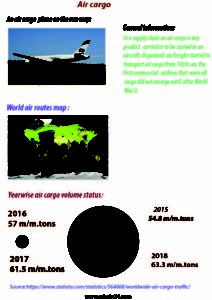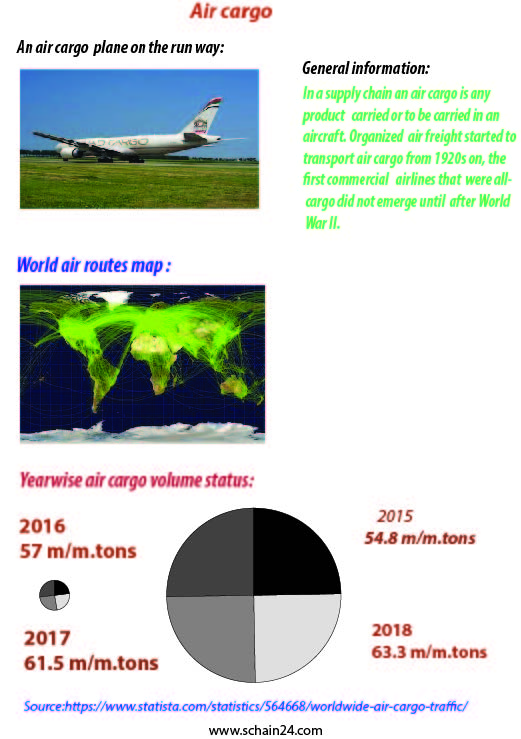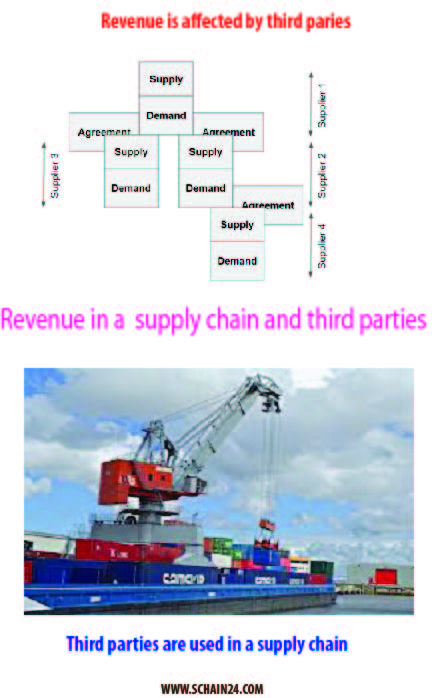Abstract:
In a supply chain an air cargo is any product carried in an aircraft. Organized air freight started to transport air cargo from the 1920s on, the first commercial airlines that were all-cargo did not emerge until after World War II. In 1945, 57 airlines formed the International Air Transport Association. The three primary air shipping options are next flight out, merged, and deferred. The key to merging air cargo is having enough shipments to merge. Optimizing a Supply Chain with Air Cargo, need to take a deeper look at the many facets and benefits of air cargo. When we need to give a quick response to market demands, we need to make air shipment. If cargo services has a higher technology such as Electronic Data Exchange, it is a plus point to choose an air transportation provider.
Keywords: Air cargo, air freight, Optimizing a Supply Chain, transportation provider.
Article:
Introduction:
Transportation denotes a movement of product from beginning of a supply chain to the customer. It is one driver of a supply chain and contributes to an enormous percentage of GDP. There are various modes of transportation used in a supply chain. Supply chains use a combination of modes of transportation i.e., air, package carrier, truck, rail, water, pipeline, inter-modal etc. Supply chains also use responsive transportation to centralize inventories and operate with a lesser number of facilities. Our current article is a discussion opportunity about air mode of transportation used in a supply chain.

An air cargo:
In a supply chain an air cargo is any product carried in an aircraft. Air cargo comprises air freight. Organized air freight started to transport air cargo from the 1920s on, the first commercial airlines that were all-cargo did not emerge until after World War II. In 1945, 57 airlines formed the International Air Transport Association. Although freight traffic developed modestly, reaching only 800,000 tons worldwide by the mid-1950s. In 1968, Boeing launched the four engines 747, the first wide-body aircraft. The 747 was the first aircraft capable of transporting full pallets in the cargo hold, revolutionizing the air cargo industry.
Basics of an air shipment:
The three primary air shipping options are next flight out, consolidated, and deferred. Air freight is often more expensive than any other mode of transportation. Incorporating the right air shipping strategy into your multi-modal, global supply chain can help reduce costs and promote efficiency. Expedited air requires a provider with the resources to locate capacity at the last minute to ensure it meets your timelines. The key to merging air cargo is having enough shipments to merge. A small provider may not work with enough companies to have regular shipments of merged air freight, which could lead to delays. Optimizing a Supply Chain with Air Cargo, need to take a deeper look at the many facets and benefits of air cargo. [1]
Optimizing a supply chain:
It is advisable that generating shipment labels, and all required paperwork electronically. Keeping in mind that shipments often have different weight and size characteristics, and time-in-transit requirements. One can easily avoid delays by making accurate and complete shipment documentation a priority. Having full tracking visibility of an air freight from the time of shipment to delivery is critical. Visibility enables us to identify problems and keep the shipments on track, avoiding potential negative impacts on time, money, and credibility. Packing a shipment efficiently will reduce the chance of incurring dimensional weight fees. If speed and reliability is the main issue price should not be a main thing to choose an air transport company. [2]
The reason we need an air shipment:
When we need to give a quick response to market demands, we need to make air shipment. When miss a production deadline, or we have a time and temperature sensitive product we need to rush for an air shipment. In this kind of situation, we need not to think of price too much. A temperature or time sensitive product usually shipped by air to increase shelf life. Usually, high value and low weight products shipped by air.
How to choose an air transport provider:
If cargo services has a higher technology such as Electronic Data Exchange (EDI) it is a plus point to choose an air forwarder/provider. A top-notch provider can offer current update of the about shipment 24/7. If these things are available, ancillary services such as customs clearance and distribution may not to be at top of mind. An experienced forwarder keeps these things in mind when give the options of business helping translate an optimized supply chain. To reach an emerging market not only in an efficient and fast way, but first also, air shipment makes a decisive role. In this way, an air cargo is making sure that a supply chain is meeting business objectives and customer needs. Not only price or freight cost, mode of shipments business and supply chain issues need to keep in mind. Taking advantage of a mode-neutral relationship with a multimodal sipping provider is a smart business move in today’s ever changing global market. [3]
Trends in air cargo:
Following somewhat slow growth in the early 2010s, the global volume of air freight has ballooned in recent years with freight volumes predicted to increase to 63.3 million metric tons in 2018.The air cargo market refers to the transportation of goods via air, either by commercial airlines or specialized freight companies. The period circa 2012 where airline fuel prices reached historic highs coincides with a sluggish growth in air freight volumes, while the increasing growth in freight volume seen from around 2016 coincides with a sharp fall in the cost of airline fuel. The largest flows of air cargo are in and between East Asia and the United States, with airports in these regions dominating the top ten in terms of freight volume. Two factors have strongly influenced the growth of the air freight market. One is e-commerce, and the other is fuel cost. [4]
Conclusion:
In, today’s multi-modal shipping environment it is necessary to think of business requirement and cost related issues simultaneously. Therefore, we can take a good decision in choosing an air transport provider or a multi-modal shipping provider. Although, history of air cargo is comparatively new in the history of business and shipping and bears a high cost it is one of the best ship-mode according to supply chain and business needs. In some emerging markets, time and temperature related products supply chain there is almost no other way except air shipment.
Reference:
1.Castle,Matt.(2015). “ Air Freight: Learning the Basics to Optimize Your Global Supply Chain”. https://www.eft.com/freight/air-freight-learning-basics-optimize-your-global-supply-chain
2.Ruriani,Deborah Catalano.(2011). “ Optimizing Air Cargo Shipments”. https://www.inboundlogistics.com/cms/article/optimizing-air-cargo-shipments/
3.Robinson,C.H. “Optimising your supply chain with air cargo”. White Paper.http://www.chrobinson.com/
4.https://www.statista.com/statistics/564668/worldwide-air-cargo-traffic/





